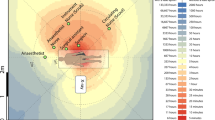Abstract
Purpose
Computer-based simulation offers radiological students the possibility to experiment with computed tomography in a way not possible in class or in clinical practice. The aim of this study was to design a computed tomography numerical simulator (CTSim) for high-quality radiological education.
Methods
In this study, a CTSim is designed based on the mathematical and physical principles of CT imaging. The proposed CTSim includes pen-beam module, fan-beam module, and clinical CT module. The core design of the software includes four parts: the construction of sample models, construction of imaging parameters and artifact parameters, design of data acquisition models under different scanning modes, and design of image reconstruction algorithm. After the design of the CTSim, the proposed CTSim was tested in every step of CT imaging.
Results
Systematic verification demonstrated that the proposed CTSim can not only perform raw CT data acquisition, image reconstruction, basic image processing, and image quality analysis like a real CT scanner, but can also simulate the formation of artifacts. The CTSim can completely get rid of the hardware and achieve the same experimental results as the hardware instrument.
Conclusion
The proposed CTSim software shows several advantages such as low cost, less room accommodation, and no ionizing radiation damage and can be used as a virtual experimental training platform to enhance teaching and learning for general X-ray CT courses or for self-study of CT practitioners.
















Similar content being viewed by others
References
Cheng S, Luo W (2009) Design and implementation of the CT teaching experimental instrument based on microcontroller. Nucl Electron Detect Technol 29(5):1218–1221
Sang B, Xiang J, Ruan C, Shang R (2003) A computed tomography experiment instrument, its development and application to student experiment. Coll Phys 22(2):33–37
Jiang S, Yang S, Ai X (2017) The design of CT imaging simulation experiment. School 24:157–169
Hu J, Qian J (2007) Design and implementation of a simulation system of CT scanning workstation. Microcomput Inf 23(10–1):224–226
Huang L, Hu H, Xu X, Zhang Y, Xu Z, Gao C, Xu W, He Y (2019) Design and implementation of CT experimental teaching system on principle display and simulation operation and imitation diagnosis. J Baotou Med Coll 35(4):112–114
Wang Z, Yu Q, Shu C, Tan R, He Q (2010) The simulation of CT filtering projection reconstruction using computer. Chin J Med Phys 27(2):1737–1740
Xiao D, Xiao J, Zhang J, Rang Q (2001) Two-dimensional fast Fourier transform and CT simulation. Coll Phys 20(7):41–43
Dong Z, Jing H, Bian Z, Niu S, Zhang H, Feng Q, Liang Z, Ma J (2015) A simple low-dose X-ray CT simulation from high-dose scan. IEEE T Nucl Sci 62(5):2226–2233
Lee CS, Reinhardt EB, Smith-Bindman R (2014) CTSim: an interactive computer simulation to learn the fundamentals of CT dose optimization. J Am Coll Radiol 11(3):255–256
Man H (2009) Computed tomography in simurad - a medical imaging simulation software. Am Soc Eng Educ 14(352):1–10
Serna A, Chans MA, Ramos A, Ramos D (2016) Clinical application of a CT dose reduction simulator. Phys Medica 32:278
Haddad P, Wong RK, Levin W, McLean M, Bezjak A (2004) Computed tomographic simulation in palliative radiotherapy: the Princess Margaret Hospital experience. Clin Oncol 16(6):425–428
Sun H, Xie K, Gao L, Sui J, Lin T, Ni X (2018) Research on pseudo-CT imaging technique based on an ultrasound deformation field with binary mask in radiotherapy. Medicine 97(38):e12532
Sun H, Lin T, Xie K, Gao L, Sui J, Ni X (2019) Imaging study of pseudo-CT images of superposed ultrasound deformation fields acquired in radiotherapy based on step-by-step local registration. Med Biol Eng Comput 57(3):643–651
Peroni M, Ciardo D, Spadea MF, Riboldi M, Comi S, Alterio D, Baroni G, Orecchia R (2012) Automatic segmentation and online virtualCT in head-and-neck adaptive radiation therapy. Int J Radiat Oncol Biol Phys 84(3):e427–e433
Stowe J, O Halloran C, Photopoulos G, Lia AD, Quinn M, Tschan F, Verwoolde R, Buissink C (2021) CTSim: changing teaching practice in radiography with simulation. Radiography 27(2):490–498
Javier C, Morvidone M, Nguyen MK (2015) Back-projection inversion of a conical Radon transform. Inverse Probl Sci En 24(2):328–352
Andersen HK, Vlgyes D, Martinsen AT (2018) Image quality with iterative reconstruction techniques in CT of the lungs-A phantom study. Eur J Radiol Open 5:35–40
Shi HL, Luo SQ, Yang Z, Wu GM (2015) A novel iterative CT reconstruction approach based on FBP algorithm. PLoS ONE 10(9):e0138498
Yang C, Wu P, Gong S, Wang J, Lu Q, Tang X, Niu T (2017) Shading correction assisted iterative cone-beam CT reconstruction. Phys Med Biol 62(22):8495–8520
Shi HL, Luo SQ (2013) A novel scheme to design the filter for CT reconstruction using FBP algorithm. BioMed Eng OnLine 12(1):50–65
Buzug T (2008) Computed tomography. Springer-Verlag, Germany
Li B (2016) TU-AB-207A-00: CT systems course. Med Phys 43(6):3739
Makarov SN, Noetscher GM, Yanamadala J, Piazza MW, Louie S, Prokop A, Nazarian A, Nummenmaa A (2017) Virtual human models for electromagnetic studies and their applications. IEEE Rev Biomed Eng 10:95–121
Yang B, Fang SB, Li CS, Yin B, Wang L, Wan SY, Xie JK, Ding Q (2013) Digital three-dimensional model of lumbar region 4–5 and its adjacent structures based on a virtual Chinese human. Orthop Surg 5(2):130–134
Kerkhof FD, van Leeuwen T, Vereecke EE (2018) The digital human forearm and hand. J Anat 233(5):557–566
Funding
This work was supported by the Natural Science Foundation of Shandong Province (ZR2017MH078) and Medicine and Health Science Development Plan of Shandong Province (202009040008).
Author information
Authors and Affiliations
Corresponding author
Ethics declarations
Conflict of interest
The authors have no conflicts of interest to declare.
Additional information
Publisher's Note
Springer Nature remains neutral with regard to jurisdictional claims in published maps and institutional affiliations.
Rights and permissions
About this article
Cite this article
He, L., Lu, W., Wang, Z. et al. CTSim: a numerical simulator of computed tomography for high-quality radiological education. Int J CARS 17, 1257–1269 (2022). https://doi.org/10.1007/s11548-022-02656-6
Received:
Accepted:
Published:
Issue Date:
DOI: https://doi.org/10.1007/s11548-022-02656-6




